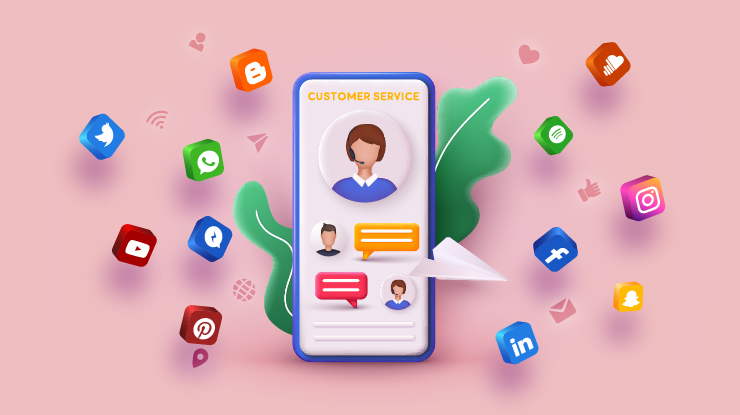In today’s digital world, social media has become an integral part of people’s lives. With billions of active users, platforms like Facebook, Twitter, Instagram, and LinkedIn provide businesses with an opportunity to engage with their customers like never before. Social media customer support has emerged as a vital aspect of modern customer service strategies. This article explores the significance of social media customer support, best practices for effective engagement, and how it can help businesses build lasting relationships with their audience.
The Importance of Social Media Customer Support

Social media platforms are more than just channels for marketing and advertising. They have evolved into platforms where customers seek solutions to their queries and express their concerns. Ignoring customer inquiries or complaints on social media can have serious repercussions for a business’s reputation. On the other hand, providing prompt and helpful responses can turn dissatisfied customers into loyal brand advocates.
Advantages of Social Media for Customer Support
- Real-Time Interaction: Social media allows businesses to interact with customers in real time, providing quick solutions to their problems.
- Enhanced Reach: With a global audience on social media, businesses can address the concerns of customers from different regions.
- Visibility and Transparency: Handling customer inquiries publicly demonstrates transparency and can improve a company’s image.
- Building Brand Loyalty: Efficient customer support on social media fosters trust and loyalty among customers.
Best Practices for Social Media Customer Support
- Dedicated Support Team: Assign a dedicated team to handle customer inquiries and complaints on social media.
- Quick Response Time: Aim to respond to customer messages and comments as quickly as possible.
- Active Listening: Pay close attention to customer feedback and sentiments to understand their needs better.
- Personalization: Address customers by their names and offer personalized solutions whenever possible.
Responding to Customer Inquiries on Social Media
When responding to customer inquiries, follow these steps:
- Acknowledge the Inquiry: Begin by acknowledging the customer’s message or comment.
- Thank the Customer: Express gratitude for bringing the issue to your attention.
- Offer Assistance: Provide a helpful and informative response to the customer’s query.
Handling Customer Complaints
Dealing with customer complaints requires tact and empathy:
- Remain Calm and Polite: Stay composed and avoid responding emotionally.
- Apologize Sincerely: Offer a genuine apology for any inconvenience caused.
- Resolve Privately: If the issue requires sharing sensitive information, move the conversation to direct messages.
Leveraging Chatbots for Efficient Customer Support
Chatbots can streamline customer support processes:
- Instant Replies: Chatbots provide immediate responses to common queries.
- 24/7 Availability: Customers can get support anytime, even outside business hours.
- Data Collection: Chatbots can gather valuable customer information to enhance future interactions.
Monitoring and Analyzing Customer Feedback
Social media insights offer valuable data:
- Feedback Analysis: Analyze customer feedback to identify recurring issues.
- Performance Metrics: Measure response times and customer satisfaction scores.
Integrating Social Media with Traditional Support Channels
Connect social media support with other channels:
- Seamless Transitions: Allow customers to switch between channels without repetition.
- Unified Customer Profiles: Maintain a consistent view of customer interactions.
Empowering Support Teams for Better Customer Engagement
- Training and Development: Provide continuous training to support teams to stay updated with best practices.
- Empowerment: Enable support agents to make decisions that benefit customers.
Personalization and Tailored Solutions
- Customer Data Utilization: Leverage customer data to offer personalized solutions.
- Tailored Content: Provide content and recommendations based on individual preferences.
Crisis Management on Social Media
- Proactive Communication: Be transparent and proactive during a crisis.
- Issue Resolution: Address concerns promptly to minimize the impact on the brand.
Building a Positive Brand Image
- Consistency: Maintain a consistent brand voice and image across all social media interactions.
- Positive Interactions: Create positive experiences for customers on social media.
Measuring the Success of Social Media Customer Support
- Customer Feedback: Monitor customer sentiment through surveys and feedback.
- Response Time: Measure average response times and aim for improvement.
Conclusion
Social media customer support has become a vital aspect of modern business operations. By embracing the power of social media for customer engagement, businesses can build lasting relationships with their audience and strengthen their brand reputation. Implementing best practices, leveraging chatbots, and personalizing interactions will ensure a seamless customer support experience, leading to increased customer loyalty and satisfaction.
Ready to provide exceptional customer support through social media? Request a demo from AIM Technologies today!
FAQs
Can customer support replace traditional support channels?
- Customer support complements traditional channels but cannot entirely replace them. Both channels are essential for providing comprehensive customer service.
How do I handle negative comments on social media?
- Address negative comments with empathy, provide solutions, and avoid engaging in public arguments.
Are chatbots capable of handling complex customer inquiries?
- While chatbots can handle simple queries, complex issues may still require human intervention.
What metrics should I track to measure customer support success?
- Key metrics include response time, customer satisfaction scores, and feedback analysis.
Can social media customer support improve brand loyalty?
- Yes, efficient and personalized customer support on social media can significantly improve brand loyalty and customer retention.




